Jeannine Atkins's Blog, page 33
July 19, 2011
Writing Retreat
I’m lucky to like my home where I have a lot of time to write, but there’s something special about being away for a few days and writing, or occasionally thinking or talking about it, pretty much from when you get up to when you go to bed. Having a lot of quiet to work in makes it easier to look at the whole patterns of your characters. It’s inspiring to see the backs or shoulders of other writers bent over laptops. Or laying out index cards. Which sets me to put questions on the structure of my own work. Or peeking into craft books. Which nudges me to remember their themes. Sneaky, yes? But I hope I lend a bit of energy or concentration, too.
I shift a few of my bad (procrastinating) habits and hope some will stick, the way I hope when I get home the little dog will be out of his habit of wanting a snack at 4 a. m.. Not likely, but we hope. The day fills with all of writing’s rhythms: one minute you have the great answer, the next you’re not so sure, and the next you sweep from despair to plodding along. As with all writing, every minute isn’t joyful, but when I get stuck, here’s my favorite revision trick. Walk down to the lake. It’s been whispering answers.

Published on July 19, 2011 05:28
July 16, 2011
Salley Mavor at the Brattleboro Museum and Art Center

Yesterday was one of those perfect summer days – not too hot, not too humid. I enjoyed writing on the porch, and in the evening, Peter and I drove north to Vermont for an opening at the Brattleboro Museum and Art Center. Several exhibits said to blur boundaries between art and craft were opening. We were there for “Sewn Stories” which held perhaps two dozen works by the amazing Salley Mavor. I’m a big fan of all her books, made by photographing work she stitched from hand-dyed wool and felt, and incorporates found objects such as acorns, driftwood, old spoons, and other trinkets. I’m so happy that Pocket Full of Posies: A Treasury of Nursery Rhymes won the 2011 Boston Globe-Horn Book Award for excellence in children’s literature and the Golden Kite Award for picture books. Lucky people going to the SCBWI conference in L.A. will get to hear her speak. And the exhibit in Brattleboro runs to February 5.
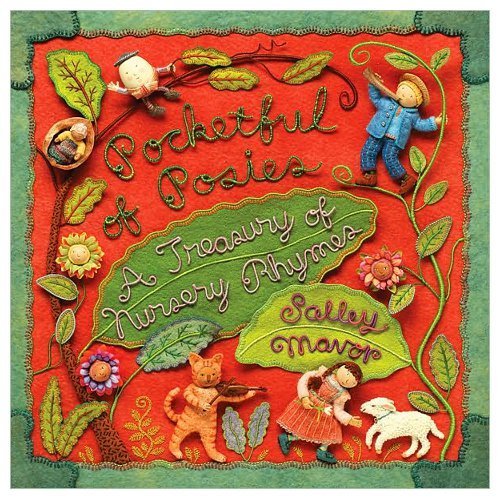
Peter took this picture of us standing before a sort of spiraling memoir of the artist from babyhood to the present. You can see this and more beautiful pictures of Salley’s artwork at Seven Impossible Things for Breakfast.

And here is Salley standing by one of her most recent works: Rabbitat.

Published on July 16, 2011 07:17
July 8, 2011
What I'm Reading: Maid as Muse by Aife Murray
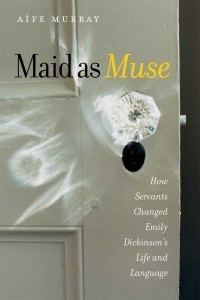
Maid as Muse: How Servants Changed Emily Dickinson’s Life and Language by Aife Murray opened my eyes to some ways a poet listened and composed. Aife Murray is devoted both to Emily Dickinson’s poems and understanding how they came to be, and this book is a record of rigorous research. She charts Emily Dickinson’s productivity through the years, and notes that she wrote the most poems when the family had good household help. Emily’s father always craved her bread and gingerbread, and she never left the kitchen for long, but when there were reliable cooks and help lighting fires, carrying water, and buying groceries, it seems she wrote more poems, particularly during the seventeen years when Margaret Maher, called Maggie within the house, was around.
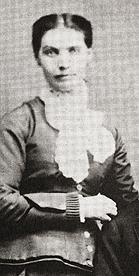
By Aife’s Murray account, Maggie was worth the work the Dickinsons did to lure her away from the Boltwoods, another respected Amherst family. In this book, she’s given respect for filling the oil lamps Emily wrote by, and saving grocery receipts, chocolate wrappers, old envelopes, and brown paper bags that Emily often composed upon. Daily conversations with Maggie may have affected the language of Dickinson’s poems. Aife Murray traveled to Ireland to hear pronunciations she speculates made rhymes and rhythms in Dickinson’s poems that wouldn’t otherwise be heard. “The queen of mimicry took an improvisational page from her servants’ books. Even her genius for ambiguity could have found influence among servants for whom the art of evasion and ambiguity were part survival strategy and, at least in the case of the Irish, part of their legal tradition.”
Perhaps most importantly, Emily stored the booklets of poetry she stitched together in Maggie’s trunk, and she asked Maggie to burn these when she died. Maggie, who’d seen the care put into the work, did not do as she was bidden: if she had, I wouldn’t be writing this post, wouldn’t, like so many of us, have read these poems. “It was a spirited, defiant act…Appealing to superiors, in this case Susan and Austin, is what would be expected from a servant.” (p. 204) Maggie found more poems she brought to Mabel Loomis Todd, who she cleaned and cooked for from 3 P.M. to 8 P.M. every day, at no charge, while Mabel Loomis Todd prepared poems for the first printed book. It was also Maggie who provided the daguerreotype we have of Emily Dickinson taken when she was sixteen. Emily’s family didn’t care for the picture and destroyed their copies.
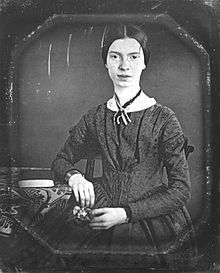
In her will, Emily Dickinson wrote the names of six Irish workmen she wanted as her pallbearers. This unusual request was respected, though Emily’s brother, Austin, asked four friends he considered more respectable to accompany them. Aife Murray interviewed descendants, and walked with one through St. Mary’s cemetery in Northampton, Mass. to find Maggie’s grave. She’s given talks and a popular tour around Amherst, which ended at Emily’s gravesite. She asked how many there were related to the pallbearers. Forty proud people raised their hands.
I loved this book, which prodded me to read more about Emily Dickinson, after a break to catch up on some novels. For Poetry Friday posts, please visit Elaine at Wild Rose Reader.
Published on July 08, 2011 05:51
July 3, 2011
July! Jama! At the Eric Carle Museum of Picture Book Art
Swimming and picnic fare with friends is planned for Monday, but my weekend struck an epitome of celebration yesterday when Jama
![[info]](https://i.gr-assets.com/images/S/compressed.photo.goodreads.com/hostedimages/1380451598i/2033940.gif) jamarattigan
and her husband took a break from visiting relatives to meet me and Peter at the Eric Carle Museum of Picture Book Art. Little is more exciting than meeting in person someone you’ve come to know and adore on their blog. Jama is as sweet and funny as you’d guess from Alphabet Soup.
jamarattigan
and her husband took a break from visiting relatives to meet me and Peter at the Eric Carle Museum of Picture Book Art. Little is more exciting than meeting in person someone you’ve come to know and adore on their blog. Jama is as sweet and funny as you’d guess from Alphabet Soup. 
We saw the Tomi Ungerer exhibit with lots of art from the Mellops, a pig family, and Jama was won over by the mother carrying a cake almost as tall as she was. There was also a bat chasing a moth with a net, crocodiles, boa constrictors, a flying kangaroo, and an octopus playing checkers and the piano. Most were drawn with delicate but assured lines, which I preferred to some of the bolder Ungerer pictures I’ve seen reprinted: of course these do look better reproduced small, and that’s why I, too, chose to put one here. Ungerer says, “If my books teach children anything, it’s to make fun of adults, especially those who are taking themselves too seriously.” Here's a recent New York Times interview.
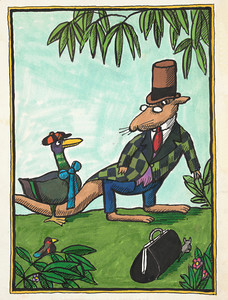
He is a friend of Maurice Sendak, who I learned was also was an early encourager of Barbara McClintock, whose work often shares his fascination with stage design. One gallery featured art from what I believe was Barbara McClintock’s first book, Heartaches of a French Cat (David Godine, 1989) which someone told me took about eight years to write and draw. Certainly her labor shows in the elegant detail. She was inspired by a Balzac play to come home and create an 87 page sketchbook from memory, and the show displays the gesture drawings and photocopies she made to experiment with different color schemes. I love the sense of place and history in all her work, and how she credits some of this to growing up near grandparents who lived in an old Victorian house, which included her grandmother’s special collection of woman writers. Sigh of happiness. I hope that collection was passed down to her.
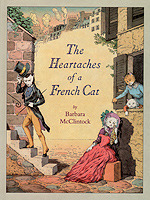
The third gallery was the one devoted to Eric Carle, which included artifacts going back to early childhood drawing and examples of the design work he did as a young man. We saw the cover of A Week with Willi Worm. Astute editor Ann Beneduce asked him to change the protagonist to a caterpillar, which became the Hungry, Hungry one we know, and offered the ending with a butterfly. There were also pages from other works, a display case with tools and examples of linoleum block prints, and a very green costume designed for a 2001 production of The Magic Flute.
After leaving the museum, Jama, our husbands, and I ate fat sandwiches and daintier carrot cupcakes at Barstow’s Longview Farm talking about life, writing, and hoping to set the ears burning of bloggers including Sara Lewis Holmes, Kelly
![[info]](https://i.gr-assets.com/images/S/compressed.photo.goodreads.com/hostedimages/1380451598i/2033940.gif) kellyrfineman, Jo
kellyrfineman, Jo
![[info]](https://i.gr-assets.com/images/S/compressed.photo.goodreads.com/hostedimages/1380451598i/2033940.gif) jbknowles, and Jules of Seven Impossible Things Before Breakfast as we marveled at their energy, wisdom, and kindness, while we enjoyed cool drinks, a warm breeze, and a view of the Holyoke Range, slow-shuffling cows, and Cornelius.
jbknowles, and Jules of Seven Impossible Things Before Breakfast as we marveled at their energy, wisdom, and kindness, while we enjoyed cool drinks, a warm breeze, and a view of the Holyoke Range, slow-shuffling cows, and Cornelius.
Now I’m drinking the delicious macadamia-cocontut tea Jama brought me via Hawaii, but already missing her smile. And hearing rain and thunder. That beautiful lake with wonderful friends may have to wait for another year, but my weekend feels pretty great.
Published on July 03, 2011 06:38
June 30, 2011
Summer!
People around here, and that’s a pretty broad “here” taking in lots of New England, have had a lot to say about rain this spring, so I was happy that the long weekend my daughter got for a visit included some sun. Being from L.A., Emily was done with mostly gray days after one and a half of them, and found it hard to believe that was our norm. I think she got the hint as we had lunch and did a few errands in Northampton, and strangers couldn’t help exclaiming over the sun that showed up. It felt like old days driving around with her and occasionally pulling out my laptop while she went off. She saw some old friends, visited her grandparents, got in some time with the dogs and her own old bed. So it was hard to leave that, but we made a family road trip to Maine, trying to pack into two days some of what we’ve eked out over two weeks in the past. There was the sound and smell of the ocean crashing on rocks, the vanishing pool at the Cliff House, shared fried clams, Moose Track ice cream, the J. Crew outlet, Harry Potter being read in the back seat, Oginquit and Kennebunkport, Maine and Portsmouth, N.H. street life and shops.

Now it’s laptop on the porch season. I still have a peaceful sense of Emily sleeping upstairs, though she’s back home, glad for a short work week following the short vacation. I’ve got a draft of a new work in the hands of my husband and writing group, so July will be devoted to some revision and wading into a new book set in a favorite time and place: Concord in the 1860s. I’m looking into kayaks on the Concord River and bike paths as my husband asks about my desire to see “buildings that aren’t there any more.” And some that are. So writing and summer fun may mix.
Published on June 30, 2011 07:14
June 17, 2011
The Frost Place and Other Wonders of New Hampshire
Last weekend my husband and I celebrated our anniversary at Lake Winnipesaukee. It was too chilly and rainy to be on the lake; we stuck to watching loons and herons. We toured Canterbury Shaker Village.

And Castle in the Clouds, a mansion built by Thomas Plant who left home at age 14 to work and retired at 51 from what was then the world’s largest shoe factory to live in a house with a view of the mountains and 36 mile long lake. We hiked by some amazing waterfalls.
Another day we were welcomed warmly at The Frost Place: A Permanent Home and Museum for Poets and Poetry in Franocnia, NH where Robert Frost lived with his wife and four children from 1915 to 1920. It was gorgeous, if remote. The hills didn’t seem suited to farming and those walls most have seemed closer and closer each long winter day. My husband asked me if this was where Frost threatened to shoot his wife, and I think it might be. That was some rough twenty or so years of writing before his first book was published.

But it was good to be there in summer, even if it was raining. Peter and I walked around a lupine and daisy filled meadow and woods with poems posted on trees. Inside the house we were invited to touch and take pictures and revel in the quietness where wonderful words were written.

I love the way this place is not just a marker of important history, but where new poems are inspired, written, and heard aloud. Readings sometimes take place in the Henry Holt Barn. I bought The Mind-Body Problem the most recent collection of Katha Pollitt who’s also well known for her political essays in The Nation, and was the first poet in residence at the Frost Place in 1977, a tradition that continues along with summer workshops.

Jone at Check it Out is covering the Poetry Friday round-up, and offering words from Jane Kenyon, another great New Hampshire poet.
Published on June 17, 2011 07:42
June 10, 2011
Poetry's Surprises
I’ve cut a swathe through the life of a historical figure, written an almost 200 page draft I’m sending to my writing group and Peter to see if the narrative running through make sense. The poems are honed down and have some good imagery, but I’ll want to know which images might be toned down or tossed, and which developed. While the manuscript is with them, I’ve been thinking about ways to strengthen individual poems. I’ve straightened out the mess of my notes on a complicated life, but now everything looks a bit too tidy and needs some kicking around, a few holes smashed to look out to wider views.
Metaphors can make us leap from one thing to another, but any kind of contrast can wake us up. Tomorrow my husband and I celebrate our 28th anniversary, which makes me think how the power of contrast is built into most vows: for richer, for poorer, in sickness and in health, for as long as we both shall live. All those years ago I had my mind on wildflowers, baking a carrot cake for forty people, ironing my cotton dress, as well as love, but right now life is simpler and I had time to get my nails done. In a day spa with pale blue walls, water running over stones, gentle music, and a request posted on the door to turn off cell phones, Shawna patiently tended to my feet with files, creams, and paint. Her demeanor was suitably low key– she was chatty, but soft spoken – and I loved finding out that she learned about Madam C. J. Walker in her cosmetology school. But the biggest kick came when she told me how she loves to watch fast cars on the Speed Channel, something I didn’t know existed. The thought of those loud racing cars, while listening to New Age music, gave me a shock of inspiration.
So I’m off to make leaps in poetry, looking for ways to draw in the unexpected. And to have a celebratory weekend, too. Maybe with a love poem that allows for the variables of a long time together, and just, I hope, gushy enough.
For Poetry Friday Roundup, please visit: Picture Book of the Day.
Published on June 10, 2011 07:53
June 3, 2011
What I'm Reading: Approaching Ice by Elizabeth Bradfield
Approaching Ice by Elizabeth Bradfield (Persea Books) is a wonderful collection of poems about exploration of the polar regions from past to present, and reflections on why some are drawn to ice, danger, or spareness. You get a taste of one answer in the poem below, which focuses on some of what was saved when Ernest Shackleton failed to reach the South Pole, but, after ice destroyed his ship, heroically found a way to keep all the men alive. I like the range of explorers mentioned, and a poem about waiting wives, which includes the poet, and “Vicarious,” which is addressed to her absent partner: “You’re not worried/ about frostbite, snow/ glare, or crevasse. Not/ about a leopard seal/ beneath the ice you walk,/ stalking. Not madness.”
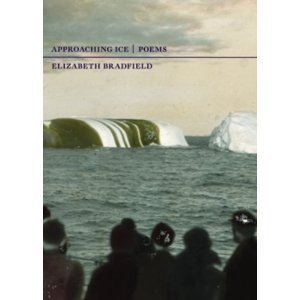
Exploration of the Arctic and Antarctic is a great subject for poems because of the mystery of both the ice and why people feel compelled to cross it, the themes of paring down, arrivals, and turnings back, and a rich often scientific vocabulary, which Elizabeth Bradfield beautifully explores. Here’s a taste:
Frank Hurley, Photographer on Shackleton's Endurance Expedition—1915
One by one he lay the glass negatives on ice
and squinted through their reversals. This one,
saved aside to be soldered into its tin box.
This one, smashed on the hard, white ground,
misgivings and reconsiderations
scattered and winking.
Yesterday, he'd broken into the cracking hull,
plunged shirtless into the slushy hold and fished out
what he could, heaved it up
onto the ice as Shackleton
tossed a gold watch, gold lighter, gold coins
onto the fissured surface before the makeshift camp,
telling the men they could take only two pounds
of unnecessary attachment from here. All of them
left something behind. But there, on the ground
that clenched and crushed their ship, they declared
what mattered most: silver nitrate
lyrics, spoken light.
Read the complete poem here.
For the Poetry Friday roundup, visit Toby Speed at The Writer's Armchair.
Published on June 03, 2011 07:17
May 30, 2011
Boston Authors Club Awards
I’m back home from a few days of traveling with Peter, including some time in Boston, where we saw some of the new American wing in the Museum of Fine Arts, splashed into the Charles River on a Duck Tour, which Peter had never done and enjoyed once the quacking died down, and I mused about people who walked on brick sidewalks about 150 years ago. We went to the beautiful Boston Public Library.

In the newer -- practical but less gorgeous -- part of the building, the Boston Authors Club hosted a lovely event to honor books selected from those written by authors with a connection to the city.
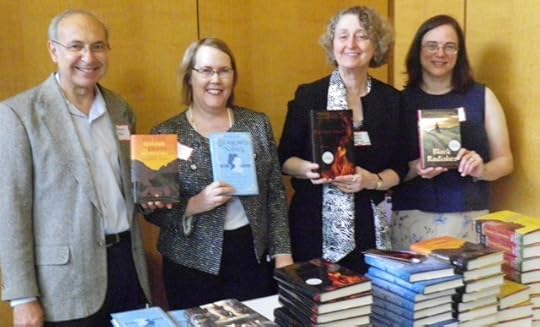
In the Young Reader category, First Prize went to The Last Summer of the Death Warriors, a story of murder, love, and redemption by Francisco X. Stork. The Other Side of the Dark, a mystery with echoes of days of slavery by Sarah Smith was a Finalist. Borrowed Names was Highly Recommended, along with Black Radishes by Susan Meyer, and another historical novel, Daughter of Winter, in which a girl tries to survive on her own, with some help from a Wampanoag woman in 1849 Massachusetts, by Pat Lowery Collins/, who couldn’t attend the ceremony.
Here’s Susan happily holding her certificate for Black Radishes, which is set in France during World War II and deals with the Resistance.
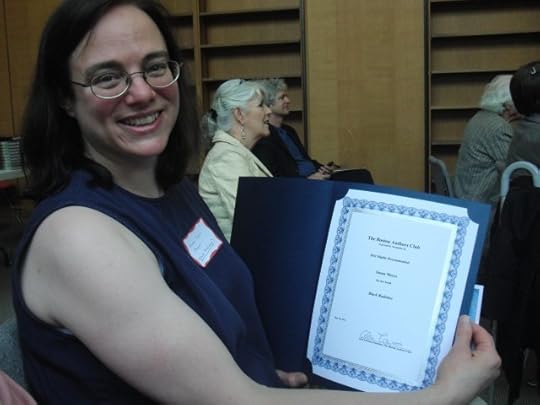
And what made Susan just as happy: seeing, she told us, for the first time, a child pick up and read her first novel. And this girl was riveted.
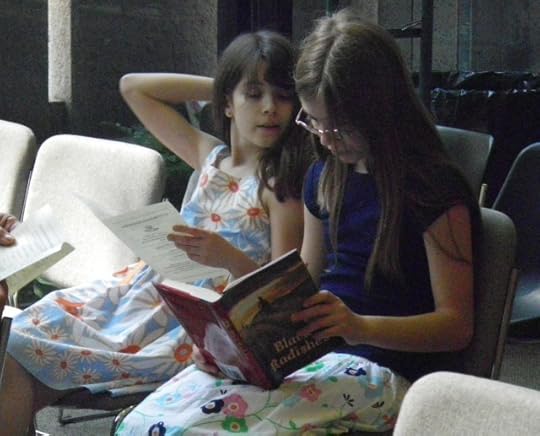
Books written for adults were also awarded prizes, and I'm currently enchanted reading Missing Lucile by Suzanne Berne, which is about the author's search for a grandmother she never knew, and whose early death haunted her father. I love the family history and research stories, and seeing the creative ways the author dealt with many missing tales.
Peter, thanks for being there and taking pictures! Thank you Boston Authors Club for your commitment to literature, and to Henry Holt Books for Young Readers for making my manuscript become a book!
Published on May 30, 2011 07:51
May 23, 2011
Quiet Weekend
On Saturday, my husband and I caught some whiffs of lilacs on our way to Cottage Street Studios where workrooms were open for sales and artists were giving a percentage of their profits to Cancer Connection. We saw lots of paintings, handcrafted pots and plates, weaving, and jewelry. As we wandered, I thought back to my recent experiences at book festivals where I wonder how much I should interact with people passing my table. Do they want a bookstore-like experience, where they quietly make up their own minds from what they see on the jacket or page? I suppose they’d then be in bookstores. But if they want some interaction with the creator, how much is too much? How do you look helpful but not needy?
We appreciated people who welcomed us into their studios, and not a single person seemed pushy. In fact, most artists were more apt to look away than showcase, and clearly most expected that most visitors were there more to look than to buy. I expect I looked at art I liked a lot and art that didn’t particularly move me with the same expression, though I tried to offer warranted compliments if the artist was watching. We who sell our wares in public have to remember that just because people don’t look long or touch or buy doesn’t mean they aren’t intrigued.

We did come home with a lovely oil painting of a shell and stones by Barbara Johnson, who is not only brilliant at her work, but is both friendly and laid back. I hope you’ll click on the link to see more of her of portraits, landscapes, still lifes, and buildings.
Then we stopped at Mt. Tom’s Homemade Ice Cream, where one of the specials was Rose Cardamom. Like eating flowers in cream and also thumbs up on service, too: when Peter ordered a double dip, they asked which flavor should go on top. I raved enough that Peter ran back in to buy me the last quart to take home. Not the brilliant pink of the azaleas in the background, but perfectly faint, like the flavor.

There was some writing, some walking, some thinking about weeding, repotting geraniums, a college graduation gathering for a girl I knew since a baby – Congratulations, Rosa! I read poems by Mark Doty, which inspired a turn in one of mine, and Lucia Perillo, which inspired me to try harder to expand my scope, in the American Poetry Review. We watched The Last Station, with Helen Mirren and Christopher Plummer, based on the end of Tolstoy’s life, which I liked a lot. Now it’s Monday morning and I’m writing on the window seat with nearby dogs resigned about the rain and a view of wet azaleas and lilies of the valley. Refreshed, inspired, creeping toward an end of a draft.
Published on May 23, 2011 07:50



